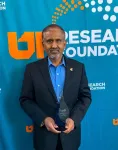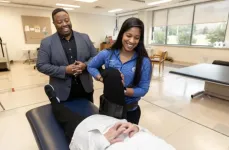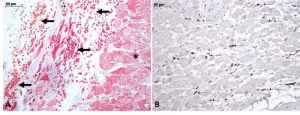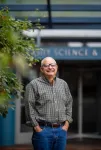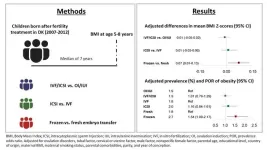(Press-News.org) MSU has a satellite uplink/LTN TV studio and Comrex line for radio interviews upon request.
Images
Pandas, long portrayed as solitary creatures, do hang with family and friends — and they’re big users of “social media.” Scent-marking trees serve as a panda version of Facebook.
An article in the international journal Ursus paints a new lifestyle picture of the beloved bears in China’s Wolong National Nature Reserve, a life that’s shielded from human eyes because they’re shy, rare and live in densely forested, remote areas. No one really knows how pandas hang, but a new study indicates pandas are around others more than previously thought. They use scent marking to keep track of both family members and friends, leave updates about life events and check out the dating scene.
Thomas Connor, lead author of the article, completed this work for his doctoral program from Michigan State University’s Center for Systems Integration and Sustainability, or MSU-CSIS, by spending months hanging out in those forests watching for signs of pandas, since actual pandas are virtually invisible. His work was built on previous observations by other MSU-CSIS scientists who suspected pandas likely weren’t the total loners everyone thought.
“Once you’ve gotten an eye for it, you can see on ridge tops and different trails the scent-marking trees, which are stained with a waxy substance — and the pandas seem to be doing this a lot,” Connor said. “It was pretty evident they were exchanging information through scent-marking behavior.”
To link the marked trees with an understanding of the pandas’ social structure, nearby panda communities needed to be documented. To explore that hunch, Connor teamed up with MSU Research Foundation Professor of Sociometrics Ken Frank, an expert on social networks and a co-author of the article.
The researchers didn’t have a camera on a bear every time it sniffs a tree. “That’s a key part,” Frank said. “I told him that once he has data on which bears are close to each other, we can use the techniques and theories that apply to humans to understand their social networks.
“And these scent trees are a social media. Like Facebook, it’s asynchronous, meaning you don’t have to be in the same place at the same time. It allows one to broadcast to many, and it’s a record. A panda marking a tree isn’t so different from a Facebook post.”
Poo: a panda portal of social insight
To determine which bears were close to one another, Connor dug into a wealth of data he had collected in the form of fresh panda poop.
Panda scat is the gold standard of panda watching. What pandas lack in obvious sociability, they make up for in poop production — going some 90 times a day. That means they leave a reliable trail. Connor was able to extract DNA from the fresh panda poop he and his colleagues collected in a 46-square-kilometer area known as prime panda habitat.
Information from the scat allowed them to identify specific pandas in the vicinity of the scent-marking trees and showed whether these pandas were related to each other. That allowed them to combine that information with that from their chosen communication method — the scent trees — to explore their social network.
“We defined two panda individuals within a certain distance from each other as an association,” Connor said. “Even if they’re not directly communicating or running into each other physically, they can exchange information in the chemical scent signature. That built up the social network for the analysis.”
Which was a revelation for an animal thought of as a loner.
Deploying a clique detector to spot social networks
Frank said once they could determine the bears were in proximity, they could apply the social network technique of community or clique detection.
“It’s pretty much like high school,” Frank said. “And like in high school, cliques have lots of implications. There are strong norms within a clique, and while encountering those outside a clique is rare, the information can be very important.”
The scent-marking trees are ripe with information, telling the sniffer who the animal is if they’ve encountered them before. It also tells the marker’s sex, an idea of how dominant and large the bear is and whether they’re ready to mate.
Connor said the most tantalizing information they gleaned is that during nonmating seasons, the pandas seem to hang mostly with other family members. But they seemed to branch out during mating seasons — likely using the scent-marking trees as a territory map.
That’s an important behavioral change, since moving out of the family groups during mating season reduces the changes of both inbreeding and competition. Connor noted this result was preliminary and limited by small sample sizes but a enticing one that should be followed up on.
“The discoveries in this study shed new light on how pandas use their habitat,” said Jianguo “Jack” Liu, senior author of the article, Rachel Carson Chair in Sustainability at MSU and CSIS director. “Pandas are a part of coupled human and natural systems where humans share their habitat. Anything we can learn about how they live and what they need can ultimately help inform good conservation policies and maybe understand our own behavior a little more.”
In addition to Connor, — now a postdoctoral fellow at the University of California – Berkeley — Frank and Liu, “Social network analysis uncovers hidden social complexity in giant pandas” was authored by Maiju Qiao, Kim Scribner, Jin Hou, Jindong Zhang, Abbey Wilson, Vanessa Hull and Rengui Li.
The work is supported by the National Science Foundation.
By Sue Nichols.
###
Michigan State University has been advancing the common good with uncommon will for more than 165 years. One of the world's leading public research universities, MSU pushes the boundaries of discovery to make a better, safer, healthier world for all while providing life-changing opportunities to a diverse and inclusive academic community through more than 400 programs of study in 17 degree-granting colleges.
For MSU news on the web, go to MSUToday or twitter.com/MSUnews.
END
MSU research suggests pandas are active posters on ‘social media’
2023-12-19
ELSE PRESS RELEASES FROM THIS DATE:
UTHSC, Vanderbilt University receive $2.4 million grant to promote diversity in speech-language pathologists for high-need children
2023-12-19
The Department of Audiology and Speech Pathology at the University of Tennessee Health Science Center and the Department of Hearing and Speech Sciences at Vanderbilt University have secured a $2,399,454 grant to fund a five-year project to address the need for diversity in highly trained professionals in speech-language pathology.
The project, known as Project PAL (Preparing Academic Leaders in Speech-Language Pathology to Teach, Conduct Research, and Engage in Professional Service to Improve Outcomes for Children with High Need Communication Disorders), ...
American University receives $5.7 million from NSF to bridge research and policy, address real-world challenges
2023-12-19
American University won a $5.7 million cooperative research agreement from the U.S. National Science Foundation’s Accelerating Research Translation program. The award will help AU foster greater use of evidence in the public and private sectors by producing new knowledge on best practices in research translation, training scholars in the effective conduct of research translation, and supporting the dissemination of research findings that have the potential to benefit society.
The ART program ...
UTRF Innovation Awards celebrate UTHSC researchers
2023-12-19
The University of Tennessee Research Foundation (UTRF) celebrated the researchers whose achievements are making life better locally, nationally, and globally at its annual Innovation Awards ceremony, held December 14 at the Mooney Library at the University of Tennessee Health Science Center (UTHSC) in Memphis.
The Innovation Awards recognize researchers from all over the UT System who partner with UTRF to bring their innovations to market. “Turning research into practical, sustainable solutions calls for resilience, adaptability, and market savvy. Let's collectively celebrate the foundational research successes that made ...
Groundbreaking hip-focused physical therapy reduces low back pain
2023-12-19
When the University of Delaware’s Gregory Hicks started his research career two decades ago, he was one of only a few people in the United States studying chronic low back pain in people over 60 years old.
Fast-forward to today, the research on back pain has ramped up, yet studies of older adults with the problem are still sparse.
“Unfortunately, the societal attitude is that older people don’t warrant the same level of care that younger people do when it comes to musculoskeletal problems,” said Hicks, Distinguished Professor of Health Sciences at UD. “But I don’t believe that for a ...
Researchers report detailed analysis of heart injury caused by yellow fever virus
2023-12-19
To fill gaps in knowledge of yellow fever (YF), a group of researchers in Brazil affiliated with the Department of Pathology at the University of São Paulo’s Medical School (FM-USP), Hospital das Clínicas (HC, the hospital complex run by FM-USP), the Heart Institute (InCor, linked to HC) and Emílio Ribas Institute of Infectious Diseases (IIER) decided to study the pathogenesis of YF-associated heart injury.
The team was led by Fernando Rabioglio Giugni, a cardiologist, and Amaro Nunes Duarte-Neto, an infectious disease specialist and pathologist; both work at FM-USP.
“There’s still no specific treatment for yellow fever. Patients receive ...
David Kaplan named fellow of the National Academy of Inventors
2023-12-19
David Kaplan, the Stern Family Endowed Professor of Engineering, has been named a fellow of the National Academy of Inventors (NAI). Election as an academy fellow is the highest professional distinction awarded solely to inventors. The NAI was founded to recognize and encourage inventors with U.S. patents and enhance the visibility of academic technology and innovation.
As a member of the Class of 2023, Kaplan will be honored at the NAI’s annual meeting on June 18, 2024 in Raleigh, North ...
Research spotlight: Structural analysis and inhibition of human LINE-1 ORF2 protein reveals novel adaptations and functions
2023-12-19
Martin Taylor, MD, PhD, a physician investigator in the Department of Pathology at Massachusetts General Hospital and an instructor in Pathology at Harvard Medical School, is the lead corresponding author of a new study in Nature, Structural Analysis and Inhibition of Human LINE-1 ORF2 Protein Reveals Novel Adaptations and Functions.
What Question Were You Investigating?
About a fifth of the human genome is half a million copies of a transposon, a virus-like element known as LINE-1 (L1). L1 was ignored as “junk DNA” for years but is increasingly recognized to contribute to the pathology of autoimmunity, ...
Assisted reproductive technologies not associated with body mass index in children, except when using frozen embryos – according to new Danish study
2023-12-19
Assisted reproductive technologies not associated with body mass index in children, except when using frozen embryos – according to new Danish study
#####
In your coverage, please use this URL to provide access to the freely available paper in PLOS Medicine: http://journals.plos.org/plosmedicine/article?id=10.1371/journal.pmed.1004324
Article Title: Overweight or obesity in children born after assisted reproductive technologies in Denmark: A population-based cohort study
Author Countries: ...
Novel approach emerging for rescuing limbs at risk
2023-12-19
Across the United States, about 2 million people are living with an amputation and another 185,000 amputations occur every year, according to the Amputee Coalition, a Washington DC-based support group. About 54% of these lost limbs were caused by vascular disease, including diabetes and peripheral arterial disease (PAD).
And as more people are diagnosed with diabetes, in the US and worldwide, the number of amputations keeps rising.
Now, experts at Cincinnati Children’s in collaboration with colleagues from Kanazawa University in Japan, have uncovered a new way to prompt blood vessel ...
Socialization for success: Two recent studies expand our understanding of how early social housing helps dairy calves thrive
2023-12-19
Philadelphia, December 19, 2023 – Dairy industry professionals continuously work to ensure the highest possible welfare for dairy calves, including fine-tuning their housing to improve overall health, well-being, and performance. Two new studies in JDS Communications are illuminating our understanding of paired housing in the critical newborn and pre-weaned stages of dairy lives by showing that housing designed to facilitate early socialization can build behavior skills, shape calf personalities, and ultimately, set up animals ...

